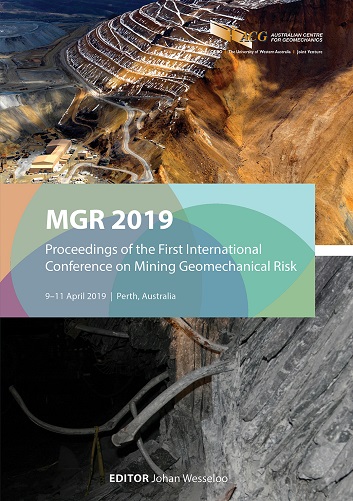Calibration of a seismic hazard assessment tool using velocity fields and geotechnical data

|
Authors: Abolfazlzadeh, Y; Smith-Bougher, L; Anderson, Z; Jalbout, A; Mataseje, A |
DOI https://doi.org/10.36487/ACG_rep/1905_12_Abolfazlzadeh
Cite As:
Abolfazlzadeh, Y, Smith-Bougher, L, Anderson, Z, Jalbout, A & Mataseje, A 2019, 'Calibration of a seismic hazard assessment tool using velocity fields and geotechnical data', in J Wesseloo (ed.), MGR 2019: Proceedings of the First International Conference on Mining Geomechanical Risk, Australian Centre for Geomechanics, Perth, pp. 233-244, https://doi.org/10.36487/ACG_rep/1905_12_Abolfazlzadeh
Abstract:
The majority of seismic hazard assessment tools are solely based on statistical analyses of several seismic source parameters such as event rate and time, and seismic moment. These analyses are often applied to the entire mining area which can impact the accuracy and reliability of the hazard assessment tool in each zone. Experience has shown that mining geomechanical risk is complex and its mitigation needs a broad understanding of other geotechnical factors such as rock mass properties, geological structures, mining method, stress regime, etc. Since all the contributing parameters and their impact are not entirely understood, it is critical to apply a range of geotechnical/geomechanical analyses in correlation to each other and quantify the changes in the rock mass behaviour. The goal of this paper is to develop a seismic hazard assessment tool calibrated for each geotechnical domain within the mine. To develop the tool, we incorporated mine geotechnical and geological data, seismic source parameters, and tomography analyses from a hard rock underground mine in North America. There exist several sub-vertical faults and one horizontal structure in the mine which create clear contrasts in rock mass behaviour across the structure. The results show good correlation among the different datasets, and a calibrated seismic hazard tool has been developed that provides ongoing updates to the mine operation.
Keywords: seismic source parameters, apparent stress trends, velocity fields, seismic hazard assessment
References:
Abolfazlzadeh, Y & Hudyma, MR 2016, ‘Identifying and describing a seismogenic zone in a sublevel caving mine’, Rock Mechanics and Rock Engineering, vol. 49, no. 9, pp. 1–17,
Brune, JN 1970, ‘Tectonic stress and the spectra of seismic shear waves from earthquakes’, Journal of Geophysical Research, vol. 75, no. 26, pp. 4997–5009.
Brown, L & Hudyma, M 2017b, ‘Identifying local stress increase using a relative apparent stress ratio for populations of mininginduced seismic events’, Canadian Geotechnical Journal, vol. 54, no. 1, pp. 128–137.
Dahlen, FA 1974, ‘On the ratio of P-wave to S-wave corner frequencies for shallow earthquake sources’, Bulletin of Seismological Society of America, vol. 64, pp. 1159–1180.
Goldcorp Inc. 2012, internal technical report, Éléonore operations, Goldcorp Inc., Quebec.
Hudyma, MR 2008, Analysis and Interpretation of Clusters of Seismic Events in Mines, PhD thesis, The University of Western Australia, Perth.
Malek, F & Leslie, IS 2006, ‘Using seismic data for rockburst re-entry protocol at Inco’s copper cliff north mine’, Proceedings of the 41st US Symposium on Rock Mechanics (USRMS): 50 Years of Rock Mechanics – Landmarks and Future Challenges.", American Rock Mechanics Association, Alexandria.
Mine Design Engineering 2017, Factual Report #1015-F1704-01: Geotechnical Mapping and Site Characterization, Goldcorp internal report, Mine Design Engineering, Kingston.
Ravenelle, JF, Dubé, & B Malo, M 2010, Insights on the Geology of the World-class Roberto Gold Deposit, Éléonore Property, James Bay Area, Quebec, Geological Survey of Canada, Ottawa.
Rawlinson, N & Sambridge, M 2003, ‘Seismic traveltime tomography of the crust and lithosphere’, Advances in Geophysics, vol. 46, pp. 81–198.
Vallejos, J & McKinnon, SD 2011, ‘Correlations between mining and seismicity for re-entry protocol development’, International Journal of Rock Mechanics and Mining Sciences, vol. 48, no. 4, pp. 616–615.
Wesseloo, J 2014, ‘Evaluation of the spatial variation of b-value’, The journal of the Southern African Institute of Mining and Metallurgy, vol. 114, pp. 823–828.
Wyss, M & Brune, JN 1986, ‘Seismic moment, stress and source dimensions for earthquakes in the California-Nevada region’, Journal of Geophysical Research, vol. 73, pp. 4681–4694.
Young, DP 2012, Energy Variations in Mining‐Induced Seismic Events Using Apparent Stress, MSc thesis, Laurentian University, Sudbury.
© Copyright 2025, Australian Centre for Geomechanics (ACG), The University of Western Australia. All rights reserved.
View copyright/legal information
Please direct any queries or error reports to repository-acg@uwa.edu.au
View copyright/legal information
Please direct any queries or error reports to repository-acg@uwa.edu.au
